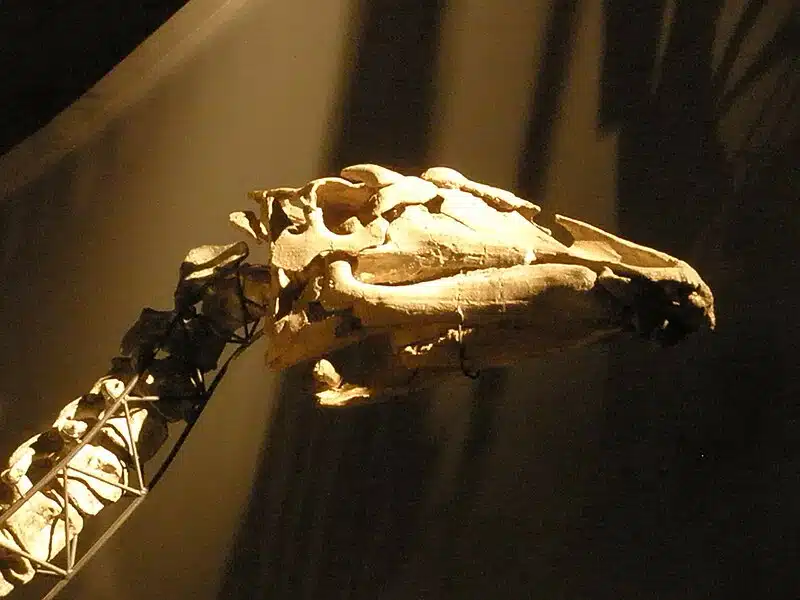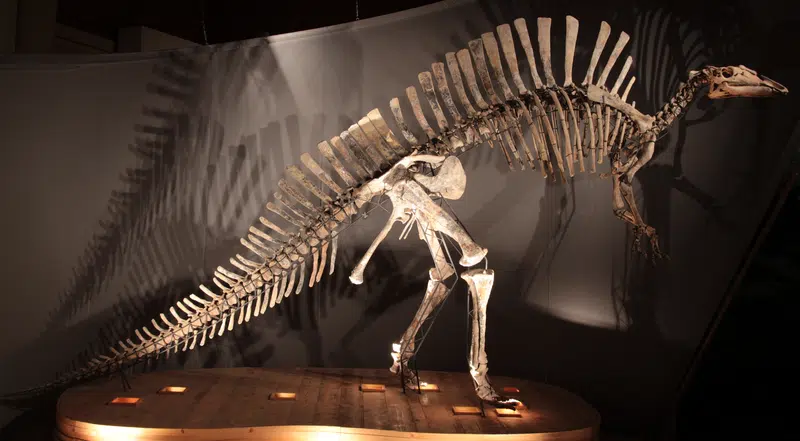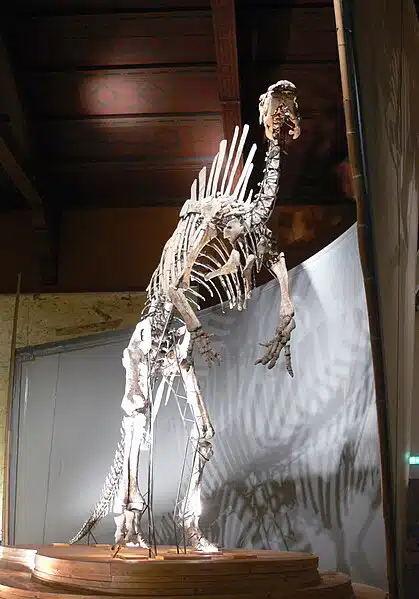Delving into the annals of prehistoric life, Ouranosaurus stands out as a fascinating subject of study. This dinosaur, whose name evokes images of ancient landscapes and forgotten worlds, offers a unique window into the Early Cretaceous Period. It captures the imagination, inviting us to explore a time when the Earth was a very different place. Ouranosaurus, or “Brave Monitor Lizard,” roamed the lands that are now part of Africa and left behind clues for us to piece together its existence and lifestyle.
The discovery of this dinosaur not only enriches our understanding of the diversity of life that once flourished on our planet but also challenges us to consider the complex web of ecological relationships that have shaped the evolution of life through the ages. As we embark on this journey through time, let us explore the world of Ouranosaurus and piece together its story from the fossils and fragments left behind to imagine the lush landscapes and dynamic ecosystems it once called home.
Ouranosaurus Key Facts
| Keyword | Fact |
|---|---|
| Pronunciation | oo-RAH-noh-sore-us |
| Meaning of name | Brave Monitor Lizard |
| Group | Ornithopod |
| Type Species | Ouranosaurus nigeriensis |
| Diet | Herbivore |
| When it Lived | 122.46 to 66.0 |
| Period | Early Cretaceous |
| Epoch | Late/Upper Aptian to the top of the Maastrichtian |
| Length | 23.0 to 27.0 feet |
| Height | Approximately 9.0 feet |
| Weight | 2.4 tons |
| Mobility | Moved on two legs |
| First Discovery | 1965 by French Palaeontological Expedition led by Philippe Taquet |
| Described by | 1976 by Philippe Taquet |
| Holotype | GDF 300 and GDI 381 |
| Location of first find | Gadoufaoua, Niger |
| Also found in | Cameroon, Sudan, Tunisia |
Ouranosaurus Origins, Taxonomy and Timeline
Ouranosaurus, whose name translates to “Brave Monitor Lizard” from Arabic, Tuareg, and Greek, offers a fascinating glimpse into the nomenclature practices of paleontology. The choice of name reflects both the physical characteristics of the dinosaur and the cultural context of its discovery. Its etymology combines the Arabic word “ourane“, meaning bravery as well as being the Tuareg name for a desert monitor lizard with the Greek “sauros” for reptile or lizard. This naming underscores the global nature of paleontological research and the collaborative effort to understand our planet’s ancient past.
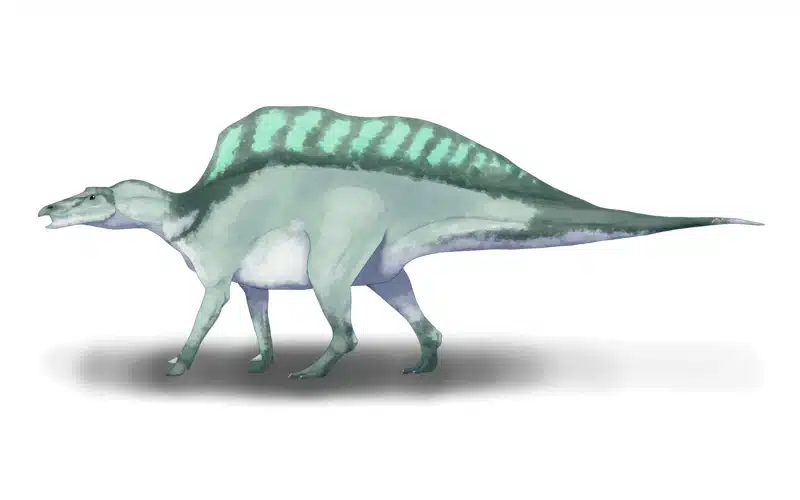
Belonging to the Ornithopod group, this dinosaur finds its place in the Iguanodontid family–a classification that speaks volumes about its diet and behavior. The type species, Ouranosaurus nigeriensis, stands alone in its genus and highlights its unique evolutionary path. This classification not only helps scientists organize the vast diversity of prehistoric life but also aids in understanding the evolutionary relationships and ecological roles of these ancient creatures.
The timeline of this herbivorous dinosaur stretches across the Early Cretaceous Period, from the late Aptian to the Maastrichtian Epoch. This vast expanse of time covers approximately 122.46 to 66.0 million years ago. In this time, Earth saw significant changes in climate, geography, and biotic communities. Ouranosaurus lived through an era of dynamic ecological shifts, adapting to new challenges and opportunities that arose as the continents continued to drift and new pathways of evolution opened up.
Discovery & Fossil Evidence
This discovery is a tale of international collaboration, meticulous fieldwork, and the unearthing of prehistoric life in one of the most challenging environments on Earth—the Sahara Desert. Between 1965 and 1972, five French paleontological expeditions led by the esteemed French paleontologist Philippe Taquet ventured into the Gadoufaoua region of Niger. These expeditions aimed to explore the deposits from GAD 5, a layer within the upper Elrhaz Formation of the Tégama Group that dates back to the Aptian stage of the Early Cretaceous.
The initial expedition, spanning January to February 1965, marked the beginning of a series of significant discoveries. Subsequent expeditions, particularly the one in February to April 1966, uncovered two more skeletons 7.0 km southeast of Elrhaz at the “Camp des deux Arbres” locality. These were designated with the field numbers GDF 300 and GDI 1700, with the former being a nearly complete but scattered skeleton and the latter two-thirds preserved. These skeletons were transported to the Muséum National d’Histoire Naturelle of Paris in 1967, where they underwent preparation.
While the third expedition did not yield additional Iguanodontian material, the fourth expedition in 1970 uncovered a nearly complete and partially articulated skeleton without the skull south of the original site. This specimen, GDF 381, was collected and transported to the MNHN by the fifth expedition in 1972.
The expeditions to Gadoufaoua have left an indelible mark on the field of paleontology, providing invaluable insights into the diversity and complexity of dinosaur life in the Early Cretaceous Period. The meticulous work of Philippe Taquet and his team, along with the subsequent efforts to analyze and display these finds, has greatly enhanced our understanding of Ouranosaurus and its contemporaries, offering a vivid glimpse into a world millions of years in the making.
- Skull of Ouranosaurus
- Mounted paratype skeleton, Museo di Storia Naturale di Venezia 3714
- Ouranosaurus nigeriensis, Royal Ontario Museum, Toronto, Ontario, Canada
- Ouranosaurus nigeriensis (Venise, museum d’histoire naturelle)
- Dorsal vertebrae
Ouranosaurus Size and Description
Ouranosaurus, a notable member of the Iguanodontian family, presents a fascinating study in dinosaur morphology and adaptation.
Size and Weight of Type Species
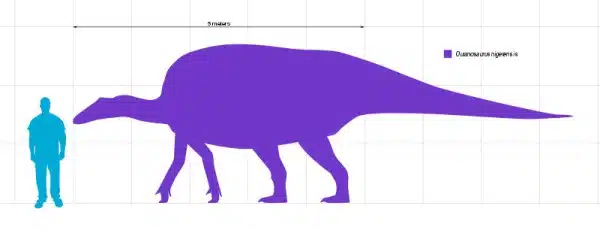
This relatively large dinosaur measured between 23.0 to 27.0 feet in length and weighed approximately 2.4 tons. The specimens studied, including the holotype and paratype, were suggested by Bertozzo and colleagues in 2017 to be subadults, yet close to their full adult size. The mounted MSNVE 3714 specimen, missing a few caudal vertebrae, measures 21.0 feet long, about 90% the length of the holotype, indicating a range of sizes within what is considered normal variation for adult Iguanodontians.
The Dinosaur in Detail
The skull of Ouranosaurus measured 67.0 cm (26.4 inches) in length and is distinguished by its low profile and elongated shape. Its flat top slopes downwards from just in front of the orbits towards both the rear and the snout, making it the most elongated skull among non-Hadrosaurid dinosaurs, although it is proportionally wider than that of related species like Mantellisaurus. Unique among Ornithopods, Ouranosaurus boasted small rounded horns in front of its eyes, adding a distinctive trait to its profile.
Its limbs suggest a versatile mode of locomotion. The front limbs were long, at 55% the length of the hind limbs. It had a very straight humerus and a lightly built, short, and broad hand, indicating that a quadrupedal stance was possible if not preferred. Each hand bore a thumb claw or spike which were significantly smaller than that of its predecessor, Iguanodon. The second and third digits were broad and hoof-like, suitable for walking. The fused bones of the wrist further would have prevented dislocation during quadrupedal movement and support this hypothesis. The last digit is presumed to be prehensile in related species for feeding but appears reduced in Ouranosaurus, suggesting a loss of this function. The hind limbs were robust, designed to support the dinosaur’s weight and allow for bipedal movement when necessary.
The most striking feature of Ouranosaurus is undoubtedly the large “sail” along its back, supported by long, wide neural spines. This sail spanned the entire length of the dinosaur’s rump and tail and looked similar to that of the carnivorous Spinosaurus, another North African dinosaur. Unlike the sails of other prehistoric creatures like Dimetrodon, the neural spines of Ouranosaurus suggest a unique evolutionary adaptation, possibly for thermoregulation, display, or another as-yet-undetermined function.
Interesting Points about Ouranosaurus
- Its dorsal sail is unique among Iguanodontids, suggesting a distinct evolutionary path or adaptation.
- This discovery in Niger, along with finds in other African countries, highlights the diversity of dinosaur life on the continent during the Early Cretaceous.
- Its diet was primarily herbivorous and reflects the rich vegetation of its era, from ferns to conifers and flowering plants.
- The bipedal and quadrupedal locomotion of this dinosaur indicates a level of agility and mobility, allowing it to forage over a wide area.
- The ongoing study of its fossils continues to shed light on the complex ecosystems of the Early Cretaceous, offering insights into the dynamics of prehistoric life.
Ouranosaurus in its Natural Habitat
This was a remarkable inhabitant of the Early Cretaceous Period in Africa that thrived within the dynamic and resource-rich environment of a river delta. This setting, characterized by its rich biodiversity and varied landscapes, provided a fertile ground for Ouranosaurus to flourish. The climate was marked by warm temperatures and high sea levels that nurtured a diverse array of plant life, from towering trees to dense underbrush.
The skull’s narrow rear, coupled with the limited area for muscle attachment, likely resulted in a less powerful bite. This anatomical feature suggests a reliance on a different strategy for processing food. The muscle configuration responsible for opening the lower jaws indicates that Ouranosaurus adeptly chewed tough plant material to break down leaves, fruits, and seeds. This allowed it to extract more energy from high-quality food sources despite its weaker bite force.
Its wide beak hints at a specialization in consuming large quantities of low-quality fodder. This was possibly an adaptation to its habitat in the river delta where these food sources would have been plentiful. The delta’s ecosystem would have provided a range of feeding options that allowed Ouranosaurus to fuel its dietary needs effectively despite its limitations. Its existence in this lush environment highlights the intricate relationships between dinosaurs and their habitats. Moreover it is offering a window into the complexity of prehistoric life and the adaptive strategies that shaped their survival.
Contemporary Dinosaurs
This medium-sized herbivore shared its world with a variety of other dinosaurs, each playing a role in the complex tapestry of prehistoric life. Suchomimus, a fish-eating giant with crocodile-like jaws, loomed larger than Ouranosaurus. These two might have crossed paths by water sources where Suchomimus prowled for its aquatic prey. It would have been largely indifferent to Ouranosaurus, who likely grazed on the higher vegetation out of reach from Suchomimus’s preferred menu.
Then there was Elrhazosaurus, a smaller, nimbler theropod that may have scavenged what larger predators left, or hunted small prey. Ouranosaurus was significantly larger and might have viewed Elrhazosaurus with a wary eye–but not as a direct threat. Their encounters would be fleeting, a quick assessment of threat levels before returning to their respective pursuits. Elrhazosaurus, with its agility, could navigate the spaces Ouranosaurus’s bulk could not, allowing it to exploit a different niche within the same environment.
Nigersaurus was a fellow herbivore that shared more directly in Ouranosaurus’s dietary habits, potentially leading to competition for food. However, Nigersaurus’s unique, wide-mouthed feeding strategy was specialized for low-lying plants. It complemented Ouranosaurus’s ability to feed from both ground level and higher vegetation. This specialization in feeding strategies could have allowed them to coexist relatively peacefully. Each filling a different ecological niche within the same lush environment. Their cohabitation exemplified the intricate web of prehistoric life, where size, diet, and behavior determined the dynamics of their relationships.
Frequently Asked Questions
It lived during the Early Cretaceous Period, approximately 122.46 to 66.0 million years ago.
As an herbivore, it primarily fed on the abundant vegetation of its time, ranging from ferns to flowering plants. Its weaker jaws meant it relied on softer vegetation.
It moved primarily on two legs. This is suggesting a level of agility and mobility that allowed it to traverse its environment effectively. It was likely able to move around quadrupedally as well, similar to some of its relatives.
Its distinctive dorsal sail, supported by elongated vertebrae, sets it apart from other dinosaurs and indicates unique evolutionary adaptations.
Sources
The information in this article is based on various sources, drawing on scientific research, fossil evidence, and expert analysis. The aim is to provide a comprehensive and accurate overview of Ouranosaurus.
Article last fact-checked: Joey Arboleda, 02-09-2024
Featured Image Credit: Audrey.m.horn, CC BY-SA 4.0, via Wikimedia Commons

